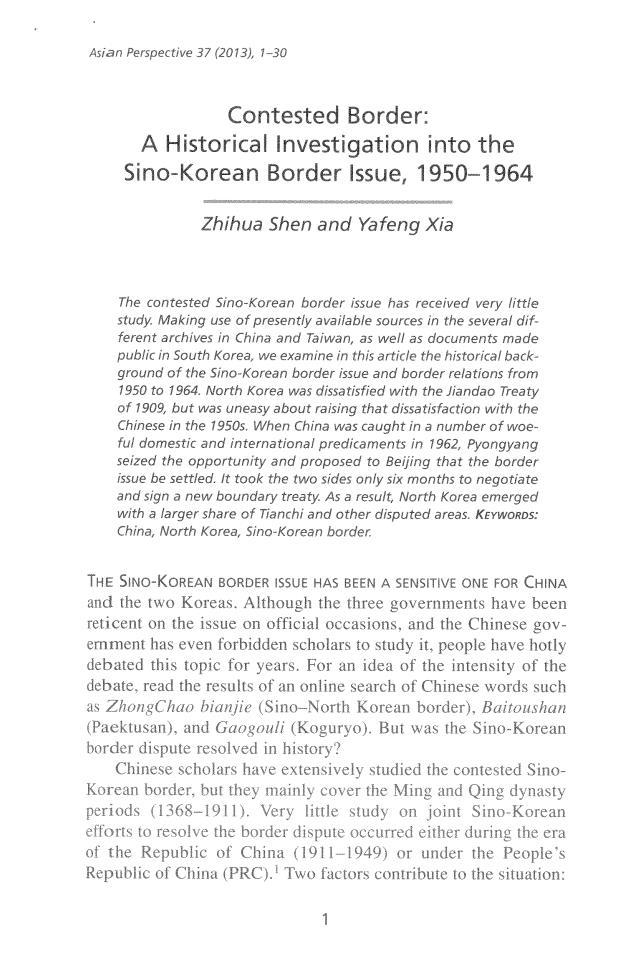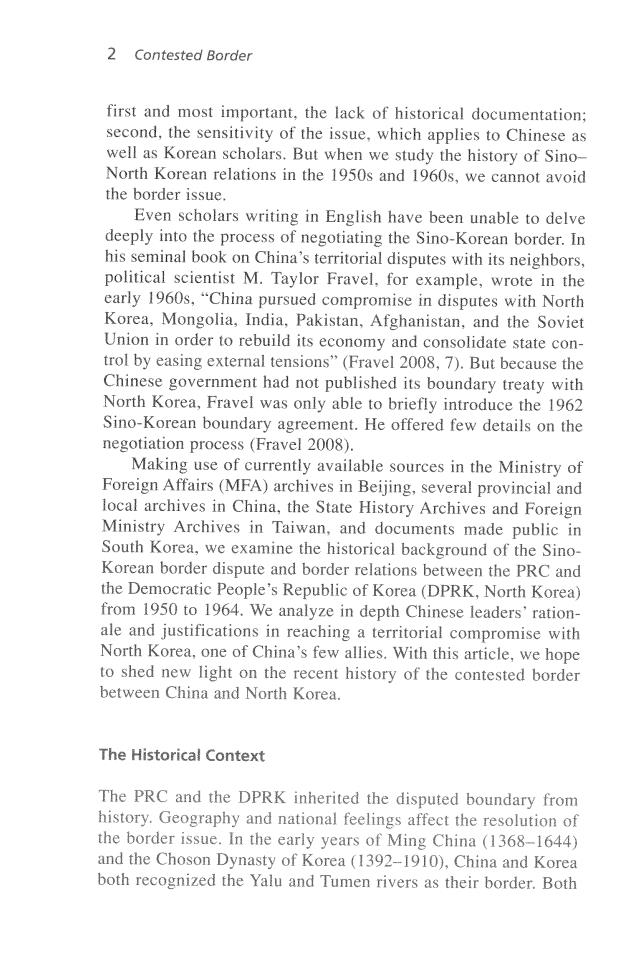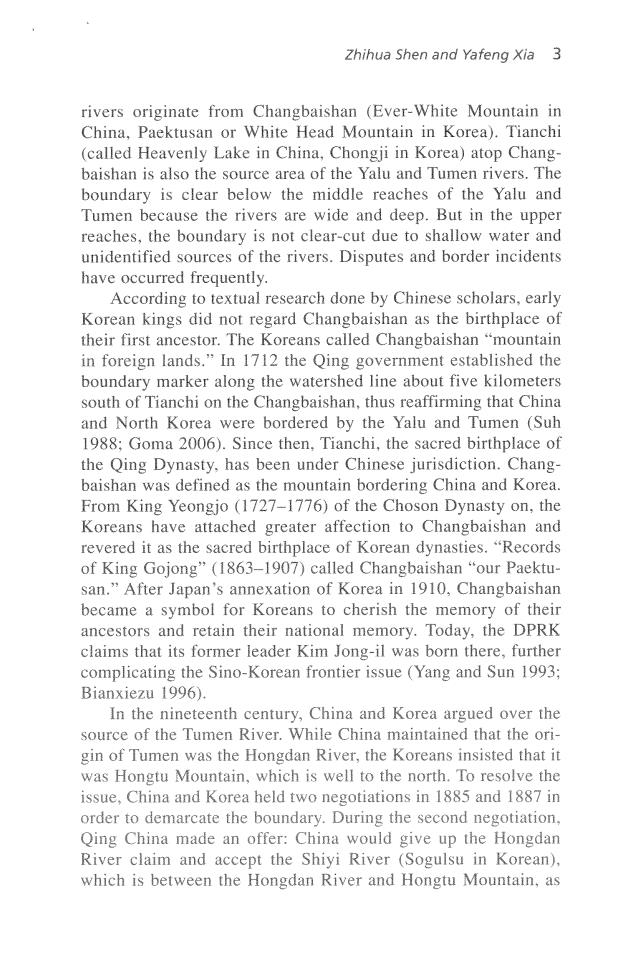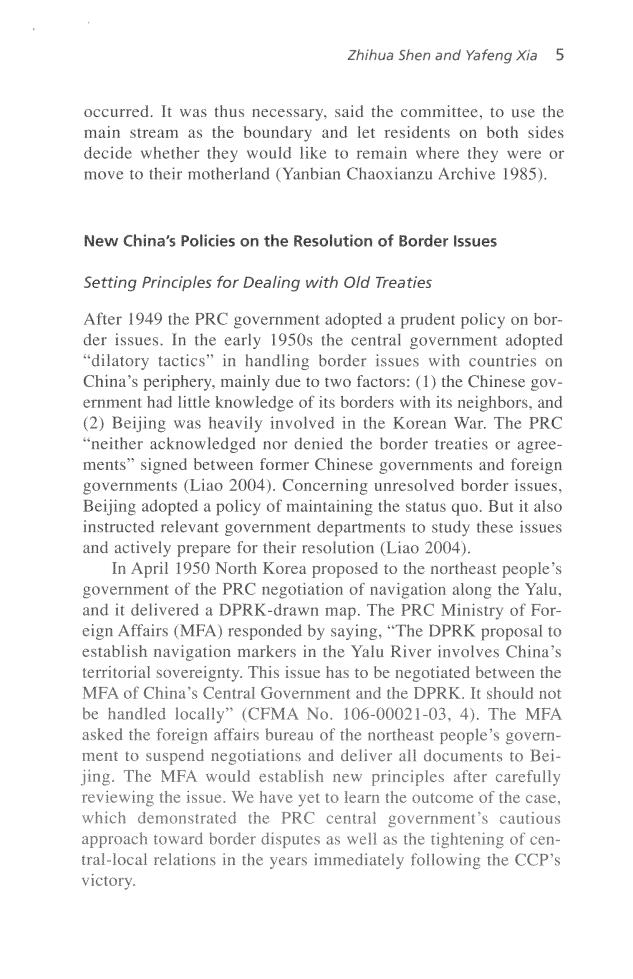
Asian Perspective 37 (2013),1-30 Contested Border: A Historical Investigation into the Sino-Korean Border Issue,1950-1964 Zhihua Shen and Yafeng Xia The contested Sino-Korean border issue has received very little study.Making use of presently available sources in the several dif- ferent archives in China and Taiwan,as well as documents made public in South Korea,we examine in this article the historical back- ground of the Sino-Korean border issue and border relations from 1950 to 1964.North Korea was dissatisfied with the Jiandao Treaty of 1909,but was uneasy about raising that dissatisfaction with the Chinese in the 1950s.When China was caught in a number of woe- ful domestic and international predicaments in 1962,Pyongyang seized the opportunity and proposed to Beijing that the border issue be settled.It took the two sides only six months to negotiate and sign a new boundary treaty.As a result,North Korea emerged with a larger share of Tianchi and other disputed areas.KEywoRDs: China,North Korea,Sino-Korean border. THE SINO-KOREAN BORDER ISSUE HAS BEEN A SENSITIVE ONE FOR CHINA and the two Koreas.Although the three governments have been reticent on the issue on official occasions,and the Chinese gov- emment has even forbidden scholars to study it,people have hotly debated this topic for years.For an idea of the intensity of the debate,read the results of an online search of Chinese words such as ZhongChao bianjie (Sino-North Korean border),Baitoushan (Paektusan),and Gaogouli(Koguryo).But was the Sino-Korean border dispute resolved in history? Chinese scholars have extensively studied the contested Sino- Korean border,but they mainly cover the Ming and Qing dynasty periods (1368-1911).Very little study on joint Sino-Korean efforts to resolve the border dispute occurred either during the era of the Republic of China (1911-1949)or under the People's Republic of China(PRC).Two factors contribute to the situation:

2 Contested Border first and most important,the lack of historical documentation; second,the sensitivity of the issue,which applies to Chinese as well as Korean scholars.But when we study the history of Sino- North Korean relations in the 1950s and 1960s,we cannot avoid the border issue. Even scholars writing in English have been unable to delve deeply into the process of negotiating the Sino-Korean border.In his seminal book on China's territorial disputes with its neighbors, political scientist M.Taylor Fravel,for example,wrote in the early 1960s,"China pursued compromise in disputes with North Korea,Mongolia,India,Pakistan,Afghanistan,and the Soviet Union in order to rebuild its economy and consolidate state con- trol by easing external tensions"(Fravel 2008,7).But because the Chinese government had not published its boundary treaty with North Korea,Fravel was only able to briefly introduce the 1962 Sino-Korean boundary agreement.He offered few details on the negotiation process(Fravel 2008). Making use of currently available sources in the Ministry of Foreign Affairs(MFA)archives in Beijing,several provincial and local archives in China,the State History Archives and Foreign Ministry Archives in Taiwan,and documents made public in South Korea,we examine the historical background of the Sino- Korean border dispute and border relations between the PRC and the Democratic People's Republic of Korea(DPRK,North Korea) from 1950 to 1964.We analyze in depth Chinese leaders'ration- ale and justifications in reaching a territorial compromise with North Korea,one of China's few allies.With this article,we hope to shed new light on the recent history of the contested border between China and North Korea. The Historical Context The PRC and the DPRK inherited the disputed boundary from history.Geography and national feelings affect the resolution of the border issue.In the early years of Ming China(1368-1644) and the Choson Dynasty of Korea(1392-1910),China and Korea both recognized the Yalu and Tumen rivers as their border.Both

Zhihua Shen and Yafeng Xia 3 rivers originate from Changbaishan (Ever-White Mountain in China,Paektusan or White Head Mountain in Korea).Tianchi (called Heavenly Lake in China,Chongji in Korea)atop Chang- baishan is also the source area of the Yalu and Tumen rivers.The boundary is clear below the middle reaches of the Yalu and Tumen because the rivers are wide and deep.But in the upper reaches,the boundary is not clear-cut due to shallow water and unidentified sources of the rivers.Disputes and border incidents have occurred frequently. According to textual research done by Chinese scholars,early Korean kings did not regard Changbaishan as the birthplace of their first ancestor.The Koreans called Changbaishan "mountain in foreign lands."In 1712 the Qing government established the boundary marker along the watershed line about five kilometers south of Tianchi on the Changbaishan,thus reaffirming that China and North Korea were bordered by the Yalu and Tumen(Suh 1988;Goma 2006).Since then,Tianchi,the sacred birthplace of the Qing Dynasty,has been under Chinese jurisdiction.Chang- baishan was defined as the mountain bordering China and Korea. From King Yeongjo(1727-1776)of the Choson Dynasty on,the Koreans have attached greater affection to Changbaishan and revered it as the sacred birthplace of Korean dynasties."Records of King Gojong"(1863-1907)called Changbaishan "our Paektu- san."After Japan's annexation of Korea in 1910,Changbaishan became a symbol for Koreans to cherish the memory of their ancestors and retain their national memory.Today,the DPRK claims that its former leader Kim Jong-il was born there,further complicating the Sino-Korean frontier issue (Yang and Sun 1993; Bianxiezu 1996). In the nineteenth century,China and Korea argued over the source of the Tumen River.While China maintained that the ori- gin of Tumen was the Hongdan River,the Koreans insisted that it was Hongtu Mountain,which is well to the north.To resolve the issue,China and Korea held two negotiations in 1885 and 1887 in order to demarcate the boundary.During the second negotiation, Qing China made an offer:China would give up the Hongdan River claim and accept the Shiyi River (Sogulsu in Korean), which is between the Hongdan River and Hongtu Mountain,as

4 Contested Border the Sino-Korean boundary.The Korean government declined the Chinese offer.After the Russo-Japanese War of 1904.Korea became Japan's protectorate and Japan controlled Korea's diplo- macy and internal affairs.On September 4,1909,China and Japan signed the Jiandao Treaty (Cando in Korean),determining that "China and Korea border along the Tumen River,and the Shiyi River is the boundary in the source area of Tumen."Tianchi on the Changbaishan and its adjacent peaks were declared to be within Chinese territory (Cai 2004,186). After the Allied victory over Japan in August 1945,the Korean peninsula was temporarily divided into two halves along the thirty-eighth parallel on the basis of an agreement between the Soviet Union and the United States.Nearly all Koreans were opposed to this division,and the Korean people aspired to form an independent country.But after the outbreak of the Cold War in Europe,the peninsula came under the control of two independent regimes in 1948.Meanwhile,the Korean people started to ques- tion the legitimacy of the Cando Treaty,with South Korea first to raise the issue(Yang 1998).But a resolution depended largely on the attitude of North Korea,which was under Soviet control.In April 1947 Xiong Shihui,director of the Chinese Nationalist gov- ernment's northeast field headquarters,twice cabled the foreign ministry to report survey and mapping activities by Soviet special agents in the Changbaishan region and in North Korea (Tang 2001).On August 26 the Chinese Foreign Ministry presented a note to the Soviet Embassy in China regarding the Soviets'mov- ing the Sino-Soviet boundary markers without China's permission (Tang2001). During the ensuing Chinese civil war (1946-1949),Yanbian was under Chinese Communist Party (CCP)control.The CCP government did not foresee any serious dispute between China and North Korea over the border(Cathcart 2010).The CCP Yan- bian prefectural committee pointed out in an August 1948 docu- ment that the China-Korea border along the Tumen River had been delimited long ago on the basis of nature and thus on the whole presented no problem.At a certain place,the change in river course or formation of a new tributary led to the conver- gence of villages and land of the two countries.Disputes thus

Zhihua Shen and Yafeng Xia 5 occurred.It was thus necessary,said the committee,to use the main stream as the boundary and let residents on both sides decide whether they would like to remain where they were or move to their motherland (Yanbian Chaoxianzu Archive 1985). New China's Policies on the Resolution of Border Issues Setting Principles for Dealing with Old Treaties After 1949 the PRC government adopted a prudent policy on bor- der issues.In the early 1950s the central government adopted "dilatory tactics"in handling border issues with countries on China's periphery,mainly due to two factors:(1)the Chinese gov- ernment had little knowledge of its borders with its neighbors,and (2)Beijing was heavily involved in the Korean War.The PRC "neither acknowledged nor denied the border treaties or agree- ments"signed between former Chinese governments and foreign governments (Liao 2004).Concerning unresolved border issues, Beijing adopted a policy of maintaining the status quo.But it also instructed relevant government departments to study these issues and actively prepare for their resolution (Liao 2004). In April 1950 North Korea proposed to the northeast people's government of the PRC negotiation of navigation along the Yalu, and it delivered a DPRK-drawn map.The PRC Ministry of For- eign Affairs(MFA)responded by saying,"The DPRK proposal to establish navigation markers in the Yalu River involves China's territorial sovereignty.This issue has to be negotiated between the MFA of China's Central Government and the DPRK.It should not be handled locally"(CFMA No.106-00021-03,4).The MFA asked the foreign affairs bureau of the northeast people's govern- ment to suspend negotiations and deliver all documents to Bei- jing.The MFA would establish new principles after carefully reviewing the issue.We have yet to learn the outcome of the case, which demonstrated the PRC central government's cautious approach toward border disputes as well as the tightening of cen- tral-local relations in the years immediately following the CCP's victory